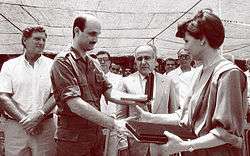Geagea–Hobeika Conflict
| Geagea–Hobeika Conflict | |||||||
|---|---|---|---|---|---|---|---|
| Part of the Lebanese Civil War | |||||||
| |||||||
| Belligerents | |||||||
|
|
| ||||||
| Commanders and leaders | |||||||
|
|
| ||||||
The Geagea–Hobeika Conflict took place in January 1986 when relations between the two dominant figures of the Lebanese Forces (LF) broke down. Elie Hobeika was president of the Lebanese Forces, and Samir Geagea was chief of staff. The conflict resulted in 800 to 1000 casualties.
The tussle between Samir Geagea and Elie Hobeika for control over the Lebanese Forces (LF) had started as early as March 1985. In March, 1985 Samir Geagea gained control over the LF after defeating the last leader of the Phalangist militia, Fouad Abou Nader. In May of that same year, however, Elie Hobeika was appointed to lead that unit. In December Hobeika signed an accord with the Syrian government, the Druze militia (PSP), and Amal (pro-Syrian Shi'a militia). One of the cornerstones of the agreement was the disbandment of Lebanese militia forces. It also provided for initiating political changes that would end Christian dominance of the Lebanese parliament and army.[1]
There was a dispute over whether to retain links with Israel and how to react to Syrian-sponsored negotiations to end fighting. Hobeika broke LF links with Israel (while Geagea had close ties to Israel) and supported the negotiations between the LF, the Lebanese government, Syria, and Muslim leaders such as Jumblatt. Geagea opposed the negotiations which he claimed would make unacceptable concessions to Syria and weaken the Lebanese Christian community's political power.
In October 1985, with negotiations in progress, skirmishes took place between Geagea's supporters and Hobeika's supporters. Geagea supporters were distributing money to Hobeika supporters to buy their allegiance. In December 1985, a peace agreement, the Tripartite Accord, was reached. It was signed by Hobeika for the LF, but the LF Command Council was split, with only half agreeing with the deal. In addition, the agreement was criticized by Camille Chamoun and some leaders of the Maronite Church.
Samir Geagea and president Amine Gemayel decided to not accept the agreement and Geagea supporters with the support of the army attacked supporters of Elie Hobeika on 8 January 1986. On 13 January, in a bid to greatly extend Hobeika's power, Hobeika's faction expanded the conflict by attacking positions of the Kataeb Party militia. The Kataeb party leader, Amine Gemayel, was at the time serving as president of the Lebanon.
The Kataeb support of the pro-Geagea faction was decisive. The conflict resulted in Geagea taking over the Lebanese Forces. Hobeika fled in a helicopter and made his way to Zahle where he formed his remaining supporters into the Lebanese Forces - Executive Command, under Syrian control. Later, Geagea attacked the Kataeb that supported him and started a consolidation of power campaign which resulted in crippling the Kataeb .

References
- ↑ "Lebanon: Information on the Jaejae, Hobeika and al-Kataeb groups". Immigration and Refugee Board of Canada. Retrieved 4 July 2013.
|first1=missing|last1=in Authors list (help)